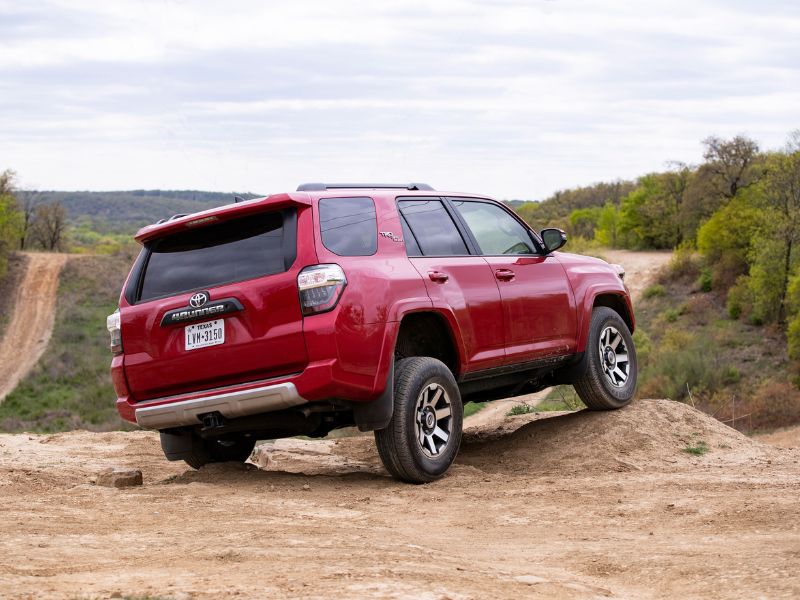The Toyota 4Runner is the swiss army knife of the Toyota stable with many models based on the same chassis as the Hilux, Land Cruiser Prado, Lexus GX, FJ Cruiser, and Tacoma using it but the Toyota 4Runner has some problems.
The Toyota 4Runner suffers from frame rust, dashboard cracking, bad head gasket, brakes locking up, and random infotainment restarts.
To help you make a more informed decision, we’ve broken down all of these common issues and looked at some Toyota 4Runner recalls you need to be aware of (especially if you have one of these models).
Table of Contents:

Toyota 4Runner Problems
1. Frame Rust
From 1997 to 2006, the 4Runner had significant issues with frame rust, so bad that some owners’ suspension components broke loose.
It happens at around 180,000 miles (289,682 kilometers) and is costly as the whole body and frame must be separated and reassembled with a new frame.
Taboo Customs on youtube has a perfect video showcasing the rust issue on a 2004 Toyota 4Runner:
2. Dashboard Cracking
The fourth generation (N210 platform) produced from 2003 to 2009 had a very poor quality dashboard that was prone to cracking even if the car was garage-kept.
It happens around 90,000 miles (144,841 kilometers), and it is an eyesore in the interior when you can see the foam through the cracks.
Luckily Coverlay makes dashboard covers for the fourth-generation 4Runner in 12 generic colors and is made in the USA.
While it isn’t a dashboard replacement, it is the next best option and is much cheaper than momo.75 on the T4R.ORG forums stating the price of a new dashboard is $1,000 plus installation.
3. Bad Head Gasket
Between 2004 and 2005, the 4Runner V6 models had an issue where the head gasket would fail, specifically at cylinder #6.
It is estimated to fail at about 158,000 miles (254,276 kilometers), so be wary of that, but luckily it does not damage the engine in most cases.
If caught early enough, only the cylinder head needs minor resurfacing, and both banks of the V6 gaskets are replaced with revised ones.
4. Brakes Locking Up
The fifth generation (N280 platform) present model has susceptible brakes, as many owners complain it doesn’t need much pressure to lock up the brakes.
Some owners experienced the 4Runner deviating off course when it happens, and then the ABS kicks in.
This doesn’t give you the confidence to take the brakes hard as a driver.
5. Random Infotainment Restarts
With the current generation, 4Runner many owners have suffered a lack of in-car entertainment when the infotainment system starts randomly restarting or shutting down.
At around 21,000 miles (33,796 kilometers), owners started noticing this strange phenomenon and the only fix was to either replace the unit or replace it with an aftermarket head unit.
Toyota 4Runner Recalls
While recalls fix vehicle issues, there is still a chance that some cars never got fixed.
Either the owner did everything DIY or took it to a private mechanic who never knew about the recalls.
So it is advantageous for you as a potential buyer or owner of a Toyota 4Runner to learn about these recalls.
And if you already own a 4Runner, take your vehicle to a dedicated Toyota dealer or trustworthy mechanic as soon as possible to rectify these problems.
2011 Recall
- 2003 to 2009 model-year vehicles, due to an unsecured floor mat, the accelerator pedal can get stuck at wide open throttle resulting in the car traveling at high speed and having difficulty slowing down.
2012 Recall
- 2012 model-year vehicles equipped with non-Toyota fitted remote engine starters can prevent communication within the vehicle’s electronics resulting in the ABS (Antilock Braking System) and stability control not functioning.
2013 Recalls
- 2009 to 2012 model-year vehicles equipped with aftermarket seat covers and DVD headrests installed, the occupant sensing system can fail to identify the occupants resulting in the airbags not deploying as they should.
- 2010 to 2011 model-year vehicles were sold with weight labels outside the 1% accuracy window stipulated by the FMVSS (Federal Motor Vehicle Safety Standards).
2014 Recalls
- 2006 to 2011 model-year vehicles may experience the cushion of the seats compressing and damaging the seat heating wiring resulting in a potential electrical short, increasing risk of fire and injury.
- 2014 to 2015 model-year vehicles may have incorrectly installed accessories manufactured by SET (Southeast Toyota Distributors), like running boards that can detach from the car and cause a road hazard.
2015 Recall
- 2010 to 2015 model-year vehicles equipped with exhaust tips installed by SET can burn people standing close behind the car.
2016 Recalls
- 2004 to 2006 model-year vehicles equipped with curtain airbags, the airbag control unit may be programmed improperly, causing the curtain airbags to deploy randomly.
- 2015 to 2016 model-year vehicles have incorrect values on the load-carrying capacity label, failing to comply with the standards of the FMVSS.
- 2010 to 2011 model-year vehicles, the front passenger airbag inflator can rupture during deployment and cause metal fragments to enter the car’s cabin, resulting in injury or death.
- 2005 to 2011 model-year vehicles equipped with aftermarket seat heaters with copper strand heating elements can cause damage to the seat cushions when compressed.
- 2016 model-year vehicles equipped with Takata PSPI-LD airbag inflators may have been manufactured without ignition booster tablets resulting in the airbag not fully deployed in the event of a crash.
2017 Recalls
- 2012 model-year vehicles, the front passenger airbag inflator can rupture during deployment and cause metal fragments to enter the car’s cabin, resulting in injury or death.
- 2016 to 2017 model-year vehicles equipped with the TFORCE package, the roof rack might be improperly tightened, resulting in detaching from the car and causing a road hazard.
- 2017 model-year vehicles, the spare tire air pressure was not adjusted correctly to match that of the tire pressure label.
- 2011 to 2016 model-year vehicles equipped with SET hood scoops, the adhesive holding the hood scoop can weaken and detach the scoop from the hood and become a road hazard.
2018 Recalls
- 2015 to 2018 model-year vehicles equipped with SET Billet Grille Overlay, the U-nut securing the grille to the car can fracture, resulting in the grille detaching from the vehicle and causing a road hazard.
- 2017 to 2018 model-year vehicles have incorrect values on the load-carrying capacity label, failing to comply with the standards of the FMVSS.
- 2013 model-year vehicles, the front passenger airbag inflator can rupture during deployment and cause metal fragments to enter the car’s cabin, resulting in injury or death.
2019 Recalls
- 2017 to 2019 model-year vehicles equipped with the TRD Package supplied by SET may have the incorrect GVWR (Gross Vehicle Weight Rating) value indicated on the certification label, thus not complying with the standards of the FMVSS.
- 2014 to 2016 model-year vehicles, the front passenger airbag inflator can rupture during deployment and cause metal fragments to enter the car’s cabin, resulting in injury or death.
- 2019 model-year vehicles, the load capacity label text can become unreadable, thus failing to comply with the FMVSS.
- 2018 to 2019 model-year vehicles, the steering and suspension components may not be adequately fastened during installation resulting in loss of vehicle control and causing a road hazard.
- 2010 to 2016 model-year vehicles, the airbag replacement of the previous recall may explode due to propellant degradation due to exposure to high humidity and temperature cycles over a long period resulting in metal fragments entering the cabin and causing injury or death.
- 2018 to 2019 model-year vehicles, the low-pressure in-tank fuel pump can fail, resulting in the vehicle stalling while driving, increasing the risk of a crash.
2022 Recalls
- 2022 model-year vehicles with auxiliary fog lights installed, the driver-side high beam can become inoperable, thus failing to comply with the FMVSS.
- 2022 model-year vehicles, the label of the load-carrying capacity text can fade and become unreadable, thus failing to comply with the FMVSS standards.
- 2020 to 2022 model-year vehicles equipped with the 20-inch Black Gunner Wheels have incorrect load-carrying capacity labels due to the wheels, thus failing to comply with the FMVSS.
Source: Cars.com

Final Thoughts On Toyota 4Runner Problems
With all these problems, it is still a desirable offroader, and the Toyota 4Runner has a very good towing capacity to boot.
The best thing to do if you own a Toyota 4Runner is to take it to a Toyota dealership and have them check for any recalls that haven’t been completed.
If you are in the market for a used 4Runner, get a full vehicle history report and avoid any models with an outstanding recall.
Hopefully, you found this article helpful, and you can go to your next Toyota 4Runner test drive knowing what to look out for.
FAQs
What Problems Does A Toyota 4Runner Have?
Rust is the biggest issue with the models spanning from 1997 to 2006 and poor head gaskets on the 2004 and 2005 models.
Other minor issues are the fourth-generation dashboards that crack, brakes quickly locking up, and random infotainment restarts on the latest models.
Is Toyota 4Runner Reliable?
Yes, with the latest consumer rating, the 2022 Toyota 4Runner scored 87 out of 100 on J.D.Power.
And many owners praise the 4Runner to this day as being tough as nails.
Is A 4Runner Better Than A Jeep?
Yes, in reliability and interior size, the Toyota is better.
In offroading, they are very evenly matched, but Toyota has packages from the factory that make it more capable than its Jeep counterpart, the Grand Cherokee.
